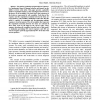Free Online Productivity Tools
i2Speak
i2Symbol
i2OCR
iTex2Img
iWeb2Print
iWeb2Shot
i2Type
iPdf2Split
iPdf2Merge
i2Bopomofo
i2Arabic
i2Style
i2Image
i2PDF
iLatex2Rtf
Sci2ools
IJCNN
2007
IEEE
2007
IEEE
A Cell Assembly Model of Sequential Memory
—Perception, prediction and generation of sequences is a fundamental aspect of human behavior and depends on the ability to detect serial order. This paper presents a plausible model of sequential memory at the neurological level based on the theory of cell assemblies. The basic idea is that sequences in the brain are represented by cell assemblies. Each item of the sequence and the sequential association between the items are represented by cell assemblies. Simulation results show that the model is capable of recognizing and discriminating multiple sequences stored in memory. The cell assemblies that represent the sequential association between two items are activated if these items occur in the input in the correct order. These sequence detecting cell assemblies form the basis of this model. A simulation presenting 100 stored sequences and 100 not stored recognizes perfectly approximately 90% of the time with no false positives.
| Added | 03 Jun 2010 |
| Updated | 03 Jun 2010 |
| Type | Conference |
| Year | 2007 |
| Where | IJCNN |
| Authors | Hina Ghalib, Christian R. Huyck |
Comments (0)

